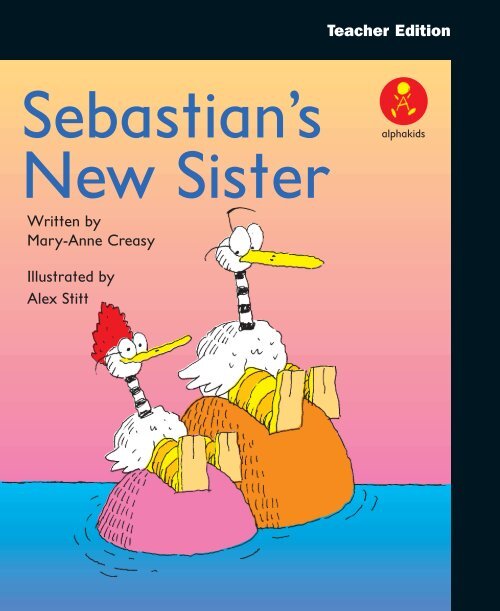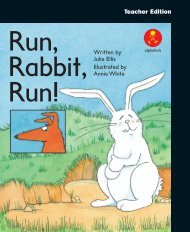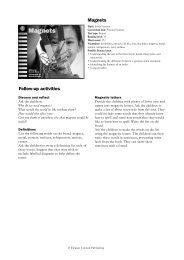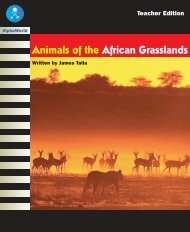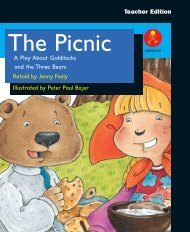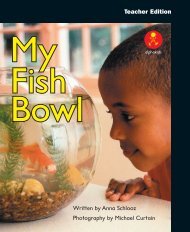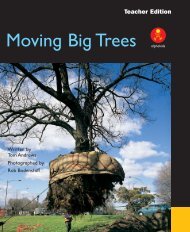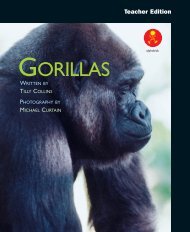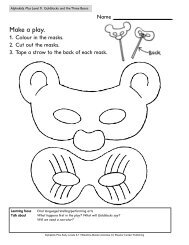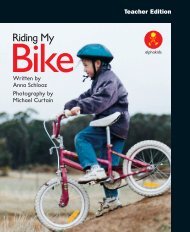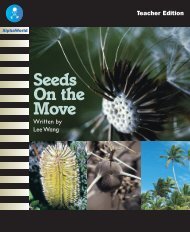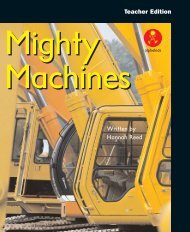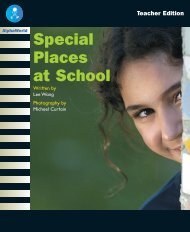Sebastian's New Sister
Sebastian's New Sister
Sebastian's New Sister
Create successful ePaper yourself
Turn your PDF publications into a flip-book with our unique Google optimized e-Paper software.
Teacher Edition<br />
Sebastian’s<br />
<strong>New</strong> <strong>Sister</strong><br />
Written by<br />
Mary-Anne Creasy<br />
alphakids<br />
Illustrated by<br />
Alex Stitt
Published edition<br />
© Eleanor Curtain<br />
Publishing 2004<br />
First published 2004<br />
Apart from any fair dealing for<br />
the purposes of study, research,<br />
criticism or review, as<br />
permitted under the Copyright<br />
Act of Australia, no part of this<br />
book may be reproduced by<br />
any process, or transmitted in<br />
any form, without permission<br />
of the copyright owner. Where<br />
copies of part or the whole of<br />
this book are made under Part<br />
VB of the Copyright Act, the<br />
law requires that records of<br />
such copying be kept and the<br />
copyright owner is entitled to<br />
claim payment.<br />
Developed by<br />
Eleanor Curtain Publishing<br />
Text: Nicole Di Marco<br />
Consultant: Susan Hill<br />
Designed by<br />
Alexander Stitt<br />
Production by<br />
Publishing Solutions<br />
Printed in China<br />
ISBN 0 7253 3409 6<br />
1 2 3 4 5 6 7 8 9<br />
04 05 06<br />
<br />
How to use this book<br />
Before reading: Talkthrough<br />
Talk through the book with the children. Encourage<br />
them to predict the text from the cover and the<br />
pictures, and to think about the information they<br />
provide. Direct the children’s attention to aspects of<br />
the text that may challenge them. Support the children<br />
to deal with these challenges by asking the<br />
Talkthrough questions on each page.<br />
During reading: Observe and support<br />
Observe the children as they read. Encourage them to<br />
monitor their own reading as they comprehend the<br />
text. As needed, support the children by helping them<br />
to discover and use reading strategies and cues to solve<br />
problems and respond to reading challenges that arise<br />
in the text. Interruptions to the children’s reading<br />
should be minimal and focused on specified learning<br />
needs.<br />
After reading: Comprehension, returning to<br />
the text, responding and writing links<br />
To further develop children’s understanding of the<br />
text, select from activities found on page 16 and the<br />
inside back cover. These whole text, sentence and word<br />
level activities reinforce the teaching focus of this<br />
book. Assessment ideas are provided to assist with<br />
planning for further teaching.<br />
Text highlights<br />
• The book features characters found in<br />
other Alphakids titles, including Sebastian<br />
(Level 9), Hiccups (Level 12) and Sebastian<br />
Learns to Fly (Level 5).<br />
• Direct speech is used.<br />
Vocabulary<br />
anywhere, counted, covered, eyes, hide-andseek,<br />
Isabella, opened, outside, Ruby, sandpit,<br />
Sebastian, yelled
Setting the context<br />
Talk to the children about their experiences<br />
when they have had to play with a younger<br />
brother or sister or any other younger child.<br />
What was it like Did you want to play with<br />
them Could they play the games you like<br />
Introducing the book<br />
This is a book about a bird called Sebastian<br />
who has to play with his baby sister, Ruby.<br />
Front cover<br />
What are Sebastian and his sister Ruby<br />
doing How do you think Sebastian is<br />
feeling Why<br />
Title page<br />
Read the title together.<br />
Point out the names of the author and<br />
illustrator.
Sebastian’s <strong>New</strong> <strong>Sister</strong> Pages 2–3<br />
<br />
Talkthrough<br />
Sebastian has a new sister. Her name is Ruby.<br />
What does Sebastian’s father want him to do Does Sebastian<br />
want to play with Ruby How do you know<br />
Observe and support<br />
Can the children use their knowledge of phonics to<br />
work out new words, such as ‘Ruby’<br />
What does the word start with What does it end with Can you<br />
break the word up<br />
2
Sebastian’s <strong>New</strong> <strong>Sister</strong> Pages 4–5<br />
<br />
Talkthrough<br />
Sebastian and Ruby go outside to play hide-and-seek.<br />
Have you ever played hide-and-seek How do you play it Does<br />
Ruby know how to play<br />
What do you think might happen<br />
Observe and support<br />
Can the children explain the purpose of quotation<br />
marks Point to the quotation marks.<br />
What are these called What do they tell you How do you know<br />
who is talking<br />
4
Sebastian’s <strong>New</strong> <strong>Sister</strong> Pages 6–7<br />
<br />
Talkthrough<br />
Sebastian covered his eyes and counted to ten. What happens<br />
next What does Sebastian say to Ruby<br />
Observe and support<br />
Do the children modulate their voices to indicate that<br />
Ruby is asking a question Point out the question<br />
mark.<br />
How can you change your voice to show that Ruby is asking<br />
Sebastian what ‘hide’ means<br />
6
Sebastian’s <strong>New</strong> <strong>Sister</strong> Pages 8–9<br />
<br />
Talkthrough<br />
What does Sebastian suggest next What happens when he<br />
covers his eyes and counts to ten How does he react to this<br />
Observe and support<br />
Can the children explain the purpose of the arrow in<br />
the illustration<br />
What is this arrow for What does it tell us<br />
8
Sebastian’s <strong>New</strong> <strong>Sister</strong> Pages 10–11<br />
<br />
Talkthrough<br />
Isabella came to play. What does Isabella ask What does<br />
Sebastian discover has happened Is he worried How do you<br />
know<br />
Observe and support<br />
Do the children pay attention to the punctuation to<br />
support expressive reading Point to the exclamation<br />
marks.<br />
What do these exclamation marks tell us How is Sebastian<br />
feeling How might you read these sentences<br />
10
Sebastian’s <strong>New</strong> <strong>Sister</strong> Pages 12–13<br />
<br />
Talkthrough<br />
Look at the pictures on these pages. Where have Sebastian and<br />
Isabella looked for Ruby<br />
Observe and support<br />
Do the children use a range of information on the page<br />
to support their reading<br />
When you looked at the pictures before you read the text, what<br />
were you looking for How did that help you What else did you<br />
check<br />
12
Sebastian’s <strong>New</strong> <strong>Sister</strong> Pages 14–15<br />
<br />
Talkthrough<br />
How will this story end Read to the end of the book and see if<br />
you were right. Where do they find Ruby What does Ruby say<br />
Observe and support<br />
Can the children read the text with expression<br />
How would Sebastian and Isabella be feeling How would you<br />
read the text on page 14 How would you read the sentence,<br />
‘Ruby was there!’<br />
14
Sebastian’s <strong>New</strong> <strong>Sister</strong> Page 16<br />
Talkthrough<br />
Does Ruby know how to play hide-and-seek How do you know<br />
What are the characters going to do now<br />
16<br />
After reading<br />
Being a meaning maker<br />
Encourage the children to support their responses<br />
with evidence from the book as they discuss these<br />
comprehension questions:<br />
What game does Sebastian try to teach Ruby<br />
Why doesn’t Sebastian think Ruby can play at the start of the<br />
book Is he right<br />
Is Ruby too young to play the games that Sebastian likes<br />
What other games might Ruby be able to play
Being a code breaker<br />
Explore the following language features:<br />
• Words that rhyme with ‘play’: bay,<br />
day, gay, hay, lay, may, pay, ray, say,<br />
stay, tray, way.<br />
• Punctuation: explore the use of<br />
quotation marks, question marks and<br />
exclamation marks to support<br />
expressive reading.<br />
Being a text user<br />
Refer to the text when discussing these<br />
questions:<br />
What kind of book is this Is it fact or fiction<br />
Would many children have had the same kind<br />
of experience as Sebastian<br />
Would this add to their enjoyment of the<br />
book<br />
Being a text critic<br />
What does the author think about brothers<br />
and sisters<br />
Are all big brothers like Sebastian<br />
Responding to text<br />
Ask the children to make a map of<br />
Sebastian’s backyard showing all<br />
the places that Sebastian and Isabella<br />
looked for Ruby.<br />
The children could complete a<br />
word substitution activity using<br />
sections of the text. After the activity they<br />
could discuss whether their changes alter<br />
the meaning of the text and whether their<br />
new version makes sense.<br />
Ask the children to look through<br />
this book and other familiar texts<br />
and find words the authors have used<br />
instead of ‘said’.<br />
Writing<br />
Select a sentence from the text that<br />
includes ‘said’ and ask the children to<br />
suggest other words that could fit. They<br />
could then work in pairs through a<br />
number of other sentences that include<br />
‘said’, providing an alternative that may<br />
make each sentence more interesting.<br />
Assessment<br />
Can the children:<br />
• explain who is talking and how this is indicated in the text<br />
• read the text fluently and expressively<br />
whole text activity sentence activity word activity
alphakids<br />
Sebastian’s<br />
<strong>New</strong> <strong>Sister</strong><br />
Written by<br />
Mary-Anne Creasy<br />
Illustrated by<br />
Alex Stitt<br />
Teacher<br />
Edition<br />
Other<br />
books<br />
at this<br />
level<br />
My<br />
Trip<br />
Written by<br />
Mary-Anne Creasy<br />
alphakids<br />
Photography by<br />
Michael Curtain<br />
Topic: Families<br />
Curriculum link: SOSE<br />
Text type: Narrative<br />
Reading level: 10<br />
Word count: 200<br />
High-frequency words: a, am, and, are, came, can,<br />
could, do, had, have, her, his, how, go, in, no, not,<br />
said, she, then, there, they, to, was, we, went, were,<br />
what, when, will, with, yes, you<br />
Vocabulary: anywhere, counted, covered, eyes,<br />
hide-and-seek, Isabella, opened, outside, Ruby,<br />
sandpit, Sebastian, yelled<br />
Baby Bear<br />
Goes Goes Visiting for a Walk<br />
Retold by Jenny Feely<br />
alphakids<br />
Illustrated by Peter Paul Bajer<br />
Reptiles<br />
alphakids<br />
Who’s That<br />
Knocking<br />
At My Door<br />
Retold by Marilyn Woolley<br />
Illustrated by Steve Axelsen<br />
Spiders<br />
alphakids<br />
alphakids<br />
Possible literacy focus<br />
Understanding and using punctuation associated<br />
with direct speech.<br />
Reading dialogue fluently and expressively.<br />
Written by Sarah O’Neil<br />
Written by Hannah Reed<br />
Photography by Patrick Honan<br />
Summary<br />
This book is a narrative about a bird called<br />
Sebastian who tries to play hide-and-seek with his<br />
younger sister.<br />
ISBN 0- 7253- 3409- 6<br />
9 780725 334093<br />
alphakids


